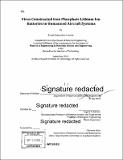Virus constructed iron phosphate lithium ion batteries in unmanned aircraft systems
Author(s)
Kolesnikov-Lindsey, Rachel.
Download1126334948-MIT.pdf (10.55Mb)
Other Contributors
Massachusetts Institute of Technology. Department of Materials Science and Engineering.
Advisor
Angela M. Belcher.
Terms of use
Metadata
Show full item recordAbstract
Since lithium ion batteries first became commercially available in 1991, they have been repeatedly improved, continually redefining just how much we can do with electronic devices. Today, battery powered Unmanned Aerial Systems (UAS) the size of a model plane such as the Raven allow soldiers to see dangerous situations and potential threats without ever needing to enter the area and put their lives in danger. This technology is saving lives and redefining warfare. However, the Raven and other UAS are limited by the amount of time they are able to spend in the air and quality of the cameras they can power. This thesis focuses on the scale up of FePO₄ lithium ion batteries that have cathodes constructed by viruses with the purpose of using them as an auxiliary battery in the Raven to power the payload equipment. These batteries are assembled at standard temperature and pressure, yet are consistently able to achieve 20nm FePO 4 particle size, creating higher energy density. A prototype auxiliary battery design is created, tested, and refined to determine how virally constructed FePO₄ batteries behave as they are scaled up.
Description
Thesis: M. Eng., Massachusetts Institute of Technology, Department of Materials Science and Engineering, 2010 Cataloged from PDF version of thesis. "September 2010." Includes bibliographical references (pages 48-49).
Date issued
2010Department
Massachusetts Institute of Technology. Department of Materials Science and EngineeringPublisher
Massachusetts Institute of Technology
Keywords
Materials Science and Engineering.